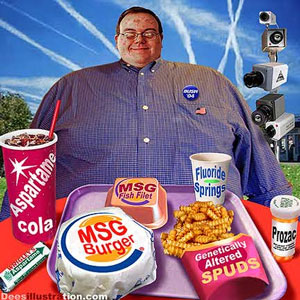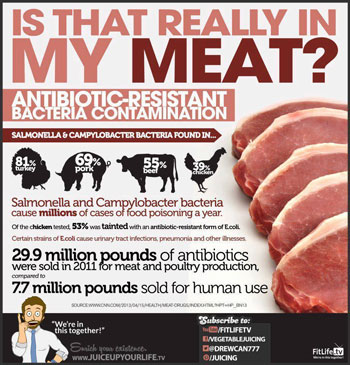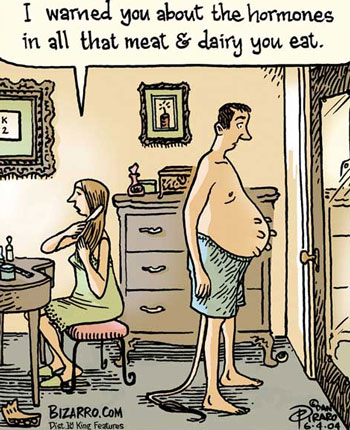What’s in your meat? Drugs, cleaning chemicals, hormones, antibiotics, heavy metals, toxins and bacteria!
Have you ever wondered what’s inside your favorite meat, pork, farmed fish or chicken burger? Many consumers do not know the beef, chicken, or farmed fish can be contaminated with drugs, cleaning chemicals, hormones, antibiotics and bacteria like E. coli.
Recently, USDA reduced the budget of federal meat and poultry inspection. What is hard to believe, although it is very true, is the fact that under its current regulations, the USDA inspection allows chicken feces or heavy metals to be used in cows or chickens’ feed. So, the delicious burger you regularly eat in your favorite restaurant could very well be made of chicken poop, stomach of dead and sick cows or cancer causing agents like sodium nitrites.

Keep in mind that most processed meats and foods (like hot dogs, processed meat, bacon, doughnuts, chips, crackers, cookies, luncheon meats and French fries) are treated with sodium nitrites. A 2008 report by the American Institute for Cancer Research shows that eating just one hot dog a day can increase the risk of developing colorectal cancer by 21%. Sodium nitrites have also been linked to stroke, coronary heart disease, lung cancer,kidney cancer, and diabetes mellitus.
How about Seafood?
The idea that seafood is safer is now doomed since 86% of seafood in US is imported from countries like China and Vietnam and most seafood sold in many restaurants or grocery stores are farmed. For example, factory farms in Asia heavily use antibiotics in their farmed raised shrimps. In fact, according to a report by ABC news, dangerous levels of illegal antibiotics are found in foreign shrimp.
In a report published by AlterNet, on ‘Why America's Favorite Seafood Is a Health and Environmental Nightmare’, the writer points out to a book by Taras Grescoe on How to Eat Ethically in a World of Vanishing Seafood. The report disturbingly states that “The shrimp pond preparation begins with urea, superphosphate, and diesel, then progresses to the use of piscicides (fish-killing chemicals like chlorine and rotenone), pesticides and antibiotics (including some that are banned in the U.S.), and ends by treating the shrimp with sodium tripolyphosphate (a suspected neurotoxicant), Borax, and occasionally caustic soda”.
If you are a fan of farmed fish you should know that tilapia in China’s farms are fed with pig and goose manure and farmed raised salmon in US are fed with pallets made of dead and sick cows. Also, farmed raised salmon are fed with pellets of chicken/turkey feces, cows (dead or sick), corn meal, GMO soy/maize, or GMO canola oil.
If you are in favor of your sushi roll made with tuna, you should know that tuna is the highest mercury fish and in fact, mercury poisoning inspired Fischer Stevens to make the Oscar-winning documentary “The Cove”, when he was poisoned with high levels of mercury in tuna.
Here are the lists of some of the nastiest contaminants in the meat supply:
1. Hormones and Antibiotics:
According to a report by alternet.org, “Each week the USDA's Food Safety and Inspection Service (FSIS) finds dangerous antibiotic levels in animals including penicillin, neomycin and "sulfa" and "cipro" drugs, many from "repeat violators."
Also, the cows in many US farms are routinely injected with synthetic hormones such as Bovine growth hormones, zeranol, trenbolone acetate and melengestrol acetate that are linked to early puberty as well as breast cancer.
Most cows are also fed with Monsanto’s GMO corn and receive growth hormones (to increase the profit by growing animals faster and squeezing them into small spaces). This means that cows get sick more often and have low immune system and as reported many times, about half of them get udder infection. Udder infection, also called, Mastitis, in dairy cattle is the persistent, inflammatory reaction of the udder tissue and is the most common disease in dairy cattle in the United States, and very costly to large commercial dairy farmers. Udder infection is cows can be very painful and in order to ease their pain, cows are injected with more antibiotics. No wonder why we see an increase in rate of antibiotic-resistant bacteria or superbugs in people. http://www.seattleorganicrestaurants.com/vegan-whole-food/Superbug-Carbapenem-Resistant-Enterobacteriaceae-CRE.php
2. Bacteria:
According to a report published in LA Times, Almost half of beef, chicken, pork and turkey tested in US grocery stores contain staph bacteria including the resistant MRSA staph bacterium (methicillin-resistant S. aureus).
In recent report by Consumer Reports, pork was also contaminated with MRSA and four other kinds of resistant bacteria. According to a report by ABC news, there have been many reports of deaths and illnesses from a batch of ground beef contaminated with E. coli bacteria.

3. Feeding sick and dead animals to other animals:
The cows are supposed to eat the green grass, not Monsanto’s genetically modified corn or chicken feces. Things are so messed up that even McDonald's (the largest fast food restaurants for using beef) is asking FDA to ban the practice of feeding chicken feces to cattle. http://articles.latimes.com/2009/oct/31/business/fi-feed31
As much as the farmed salmon industry is going to hate this true statement, the truth is that farmed salmon:
- >> has almost 10 times the level of PCB’s as compared to wild salmon
>> has 30 times the number of sea lice as compared to wild salmon
>> are fed colored pellets to give them color
>> are fed pellets of chicken/turkey feces, corn meal, GMO soy/maize, or GMO canola oil
>> are fed pellets with antibiotics at higher levels than any other livestock because of water toxins
>> have less omega 3 fatty acid due to the type of diet fed
>> are grown in very small spaces resulting in more disease infested water and pollution
Out in nature you do not see cows eating chickens or fish eating dead or sick cows. Only human beings are capable of doing such horror for the sake of corporate profit. This is how mad cow disease might contaminate the entire US meat industry. Although many people have long forgotten about Mad Cow Disease, according to alternet.org, “the US final report about the first US mad cow is found in December 2003, the government said "all potentially infectious product" from the deadly cow "was disposed of in a landfill in accordance with Federal, State and local regulations. The sources of the Mad Cow Disease seen in a second and third cow were never found but the government protected the identities of the Texas and Alabama ranches and let them sell beef again within a month. Mad Cow and related diseases like Chronic Wasting Disease in deer are transmitted by prions which are "rogue proteins" that are not destroyed by cooking, heat, autoclaves, ammonia, bleach, hydrogen peroxide, alcohol, phenol, lye, formaldehyde, or radiation, and they remain in the soil, contaminating it for years.”
Since the antibiotics are losing their full affectivity, the meat industry is getting creative by using high volumes of bacteria-killing chemicals and even sprays made out of viruses called bacteriophages to quell the germfest. A recent report shows that Chicken slaughterhouses are using high volumes of new bacteria-killing chemicals to hide the presence of salmonella. http://www.seattleorganicrestaurants.com/vegan-whole-food/factory-chickens-bacteria-killing-chemicals-salmonella.php
Another main cleaning product that’s commonly used by the meat industry is chlorine. According to the website MeatPoultry.com, "99 percent of American poultry processors" cool their "birds by immersion in chlorinated water-chiller baths." Also, another report by Washington post shows that chlorine-washed chicken are preventing the U.S.-E.U. trade while many Americans remain blissfully ignorant about what they are eating. According to Reuters, “The U.S. policymakers have long been frustrated by what they consider the EU's "non-scientific approach" to food safety that has blocked imports of U.S. genetically modified crops, poultry treated with chlorine washes to kill pathogens and meat from animals fed the growth stimulant ractopamine.”

Did you know that 45% of US pig farms use asthma-like drug known as ractopamine that can cause stress and hyperactivity in animals? In a report published in the journal Talanta, Dr David Wallinga said that “Adding these drugs to waterways or well water supplies via contaminated animal feed and manure runoff is a concern, because this class of drugs is so important in treating children with asthma”.
The researchers at Portsmouth University also found that fish is contaminated with the anti-depressant drug known as ‘Prozac’ when the drug enters the rivers via sewer system and tinkers and affects fish.
There are also up to 20 different hormones (both natural oestrogen and 7-beta-estradiol), antibiotics, anti-fungal drugs, steroids and Anti-malaria drugs (pyrimethamine) in milk and dairy products. http://www.seattleorganicrestaurants.com/vegan-whole-food/chemicals-antibiotics-in-milk-glyphosate-toxic-to-dairy-cows.php
5. Toxins and heavy metals:
A 2010 USDA report found high levels of arsenic, veterinary drugs and copper in beef consumed in US. In fact, arsenic is regularly added to the diet of conventionally raised chickens by the food industry on purpose and to your surprise, FDA has already called the arsenic level in conventionally raised chickens within the safety limits. http://www.seattleorganicrestaurants.com/vegan-whole-food/FDA-guidelines-about-free-range-chickens-arsenic-contamination-nitarsone-drug.php In fact, the FDA funded study found high levels of inorganic arsenic in the liver of chickens treated with arsenical drugs such as nitarsone (in order to enhance the growth of chickens and treat intestinal parasites in birds).
In addition, according to a document by EPA, FDA regulates formaldehyde as a food additive used as a defoaming agent, and in the feed of animals used for food sources including some chicken and fish. http://www.epa.gov/teach/chem_summ/Formaldehyde_summary.pdf. Formaldehyde can cause cancer including leukemia and short term exposure can cause watery or burning eyes, asthma, headaches, skin irritation, and nausea. Formaldehyde is banned in many countries including the European Union.
Other toxins such as carbon monoxide are also added to meat to keep the meat’s color red and its appearance fresh. In fact, according to alternet.org, “a few years ago, consumer groups tried to stop the practice of "modified atmosphere packaging" (MAP): exposing meat to carbon monoxide to keep it looking fresh. They weren't successful. Today as much as 70 percent of meat packages in stores are treated with carbon monoxide to keep the meat's red color (oxymyoglobin) from turning to a brown or gray color (metmyoglobin) through exposure to oxygen”.
Although the meat industry claims that MAP is harmless and keeps the meat products affordable, the European Commission's Scientific Committee on Food and USDA's Food Safety Inspection Service have expressed concerns about MAP. Yet, thanks to MAP, meat can stay red and fresh for almost an entire year!
Sources:
http://www.alternet.org/food/9-nastiest-things-meat-you-eat
http://abcnews.go.com/Health/Wellness/coli-concern-tainted-beef-makes-consumers/story?id=8987973


